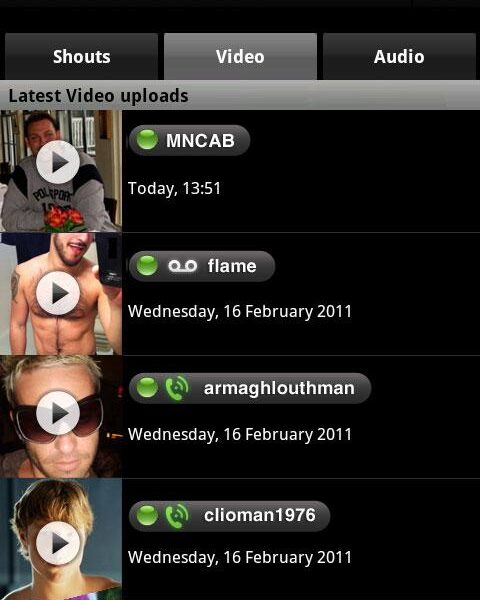In the vibrant tapestry of contemporary culture, the term “maleforce gay” emerges as a nuanced thread weaving together elements of identity, empowerment, and societal critique. As our understanding of sexuality continues to evolve, this term invites both curiosity and contemplation. It beckons us to explore the complexities of masculine identity within the LGBTQ+ community, illuminating the intersection of power, vulnerability, and expression. In this exploration, we aim to dissect the cultural narratives that shape our perceptions and the lived experiences of those who identify with this concept. Join us as we delve into the layers of meaning, the histories intertwined with these identities, and the ongoing dialogue surrounding maleforce gay in today’s world.
Table of Contents
- Understanding Maleforce Gay Dynamics in Contemporary Relationships
- Navigating the Spectrum of Power and Consent in Maleforce Contexts
- Fostering Healthy Communication Within Maleforce Gay Interactions
- Empowering Positive Experiences: Best Practices for Maleforce Gay Explorations
- Q&A
- To Wrap It Up
Understanding Maleforce Gay Dynamics in Contemporary Relationships
In the evolving narrative of gay relationships, the dynamics of power and influence take on a distinct form, often termed as “maleforce.” This term encapsulates the intricate ways in which masculinity, societal expectations, and sexual identity intertwine. Power plays can manifest in various settings, whether in casual encounters or long-term partnerships. Understanding these dynamics requires a nuanced look at how cultural backgrounds, personal experiences, and emotional vulnerabilities shape interactions. Central to this understanding is recognizing that these influences can empower or disempower partners, highlighting the need for open communication and mutual respect.
Moreover, the exploration of this dynamic often invites discussion around concepts like dominance and submission, which can attract individuals seeking different relational experiences. Here are some key aspects that often arise in these discussions:
- Emotional Availability: How partners share their feelings significantly impacts the relationship’s strength.
- Expectations: Preconceived notions about roles can lead to misunderstandings if not openly discussed.
- Boundaries: Establishing clear boundaries helps mitigate potential conflicts.
In navigating these often complex interactions, individuals may benefit from a framework that aids in recognizing their patterns. A simplified view of relationship dynamics can be illustrated in the table below:
| Dynamic Aspect | Positive Impact | Negative Impact |
|---|---|---|
| Communication | Builds trust | Leads to resentment |
| Power Balance | Creates equality | Fosters dependency |
| Emotional Responsiveness | Enhances connection | Causes emotional distance |
Navigating the Spectrum of Power and Consent in Maleforce Contexts
In the intricate landscape of maleforce contexts, understanding the dynamics of power and consent becomes essential. This spectrum can often blur the lines between dominance and submission, revealing the complex interplay between desire and vulnerability. Acknowledging the nuances within these interactions is crucial for fostering environments that prioritize mutual respect and understanding. Key aspects that require exploration include:
- The Role of Communication: Establishing clear dialogue prior to engaging in any maleforce scenario can prevent misunderstandings and ensure that all parties are on the same page.
- Consent Dynamics: Consent should be enthusiastic and ongoing, allowing space for renegotiation as circumstances evolve.
- Power Exchange: The intentional transfer of power can create a thrilling atmosphere, yet it necessitates a solid foundation of trust.
As we dissect the implications of power in these settings, it becomes evident that empowerment is not simply about control, but rather about creating a safe space for exploration. Effectively navigating these challenges requires a commitment to ethical practice, which is outlined in the table below:
| Practice | Description |
|---|---|
| Active Consent | Clear and enthusiastic agreement from all parties involved before engaging. |
| Safety Planning | Establishing protocols and safewords to ensure comfort and security. |
| Debriefing | Post-activity discussions to reflect on experiences and address any concerns. |
Fostering Healthy Communication Within Maleforce Gay Interactions
Creating an environment where open dialogue thrives is essential in fostering understanding and respect among individuals engaged in mutual attraction. Practicing active listening goes a long way in building trust and valuing each other’s perspectives. Key practices to embrace include:
- Clarifying Intentions: Ensure both parties are on the same page regarding their feelings and desires.
- Respecting Boundaries: Always be mindful of personal space and emotional limits.
- Providing Affirmative Feedback: Reinforcing positive behaviors can strengthen bonds and encourage authenticity.
Moreover, it is crucial to address communication barriers that may arise from societal pressures or individual experiences. Creating a safe space for open discussions allows for the exploration of deeper feelings and concerns without fear of judgment. Consider implementing the following techniques:
| Technique | Benefit |
|---|---|
| Regular Check-ins | Fosters a habit of open communication and emotional check-ups. |
| Conflict Resolution Steps | Prepares both parties to address disagreements respectfully. |
| Non-Verbal Cues Awareness | Enhances understanding of each other’s emotional states. |
Empowering Positive Experiences: Best Practices for Maleforce Gay Explorations
Embarking on explorations as a male identifying individual presents opportunities to create and share vibrant, positive experiences. To ensure that these journeys are enriching and respectful, consider incorporating the following best practices:
- Be Open-Minded: Embrace diversity in experiences and connections, allowing for personal growth and understanding.
- Communicate Clearly: Establish boundaries and expectations with other participants to foster mutual respect and comfort.
- Promote Safe Spaces: Engage in environments that uphold respect and inclusivity, enabling everyone to express themselves freely.
- Practice Active Listening: Value the voices of others and engage in meaningful dialogues that celebrate diverse perspectives.
Additionally, organizing small group interactions can cultivate deeper connections and a sense of community. Consider utilizing structured activities that allow for shared interests, ensuring everyone feels involved:
| Activity | Description | Purpose |
|---|---|---|
| Workshops | Interactive sessions focused on skill-building or personal development. | Enhance knowledge and foster shared experiences. |
| Discussion Circles | Open forums for sharing thoughts on relevant topics. | Encourage dialogue and deeper understanding. |
| Social Events | Casual meet-ups for networking and relationship-building. | Strengthen community bonds in a relaxed atmosphere. |
Q&A
Q&A on Maleforce Gay: Understanding the Concept
Q1: What is “maleforce gay”?
A1: ”Maleforce gay” refers to a complex and often controversial discourse surrounding masculinity within the LGBTQ+ community, particularly as it relates to gay identities. The term blends “male” and “force,” suggesting a certain assertion of masculine traits, often in contrast with societal norms or stereotypes about how gay men are perceived. It encapsulates a spectrum of expressions and experiences, examining the intersections of power, sexuality, and identity.
Q2: How did the term originate?
A2: The origins of “maleforce gay” can be traced back through discussions in online forums and academic explorations of masculinity in queer spaces. As conversations about gender and sexuality evolved, so too did the need to articulate the nuanced ways in which gay men relate to ideas of power, assertiveness, and traditional masculinity. Various cultural critiques and artistic representations have subsequently popularized the phrase, embedding it into contemporary LGBTQ+ dialogue.
Q3: What are some characteristics associated with maleforce gay?
A3: Characteristics often attributed to maleforce gay include a strong assertion of masculinity, sometimes manifested in behavior, style, or ideology. Those identifying with this concept may elevate traditional masculine traits such as assertiveness or emotional stoicism. Nevertheless, it’s essential to note that maleforce gay is not monolithic; its expressions can vary greatly from person to person, often influenced by cultural background, personal experiences, and social contexts.
Q4: How does maleforce gay intersect with broader discussions on masculinity?
A4: The concept of maleforce gay opens up a dialogue about the expectations placed on men within both heterosexual and homosexual contexts. It challenges rigid definitions of masculinity and invites a broader understanding of what it means to be a man in today’s society. By examining how gay men navigate these ideals, maleforce gay encourages a reflection on gender roles, power dynamics, and the diversity of masculine identities.
Q5: Can maleforce gay be considered a positive or negative construct?
A5: As with many concepts related to identity and social discourse, maleforce gay can have both positive and negative connotations, largely depending on context. On one hand, it can empower individuals to embrace and celebrate different aspects of their masculinity. On the other hand, it may also perpetuate certain stereotypes or pressures to conform to narrow definitions of masculinity. Ultimately, interpretations may vary, and individuals may find personal meaning or critique within the framework.
Q6: What impact does maleforce gay have on societal perceptions of gay men?
A6: The impact of maleforce gay on societal perceptions is multifaceted. It can challenge stereotypes that depict gay men as effeminate or weak, paving the way for a more nuanced understanding of masculinity and sexual identity. However, it can also reinforce harmful tropes if misinterpreted or overly generalized. As cultural narratives continue to evolve, conversations surrounding maleforce gay will play a vital role in shaping how society views and interacts with diverse expressions of masculinity within the LGBTQ+ community.
Q7: How can individuals engage with the concept of maleforce gay positively?
A7: Individuals can engage with maleforce gay positively by fostering open discussions about masculinity, celebrating diversity, and combating restrictive norms. Communities can encourage supportive spaces where all expressions of male identity, including those that might be labeled as maleforce, are accepted and valued. By educating themselves and others on the complexities of masculinity, individuals can contribute to a more inclusive dialogue that enriches our understanding of gay identities and challenges societal expectations.
To Wrap It Up
As we conclude our exploration of the concept of “maleforce gay,” it’s essential to understand that this term embodies a complex interplay of identity, expression, and societal perception. It challenges traditional narratives surrounding masculinity and sexuality, inviting us to reevaluate our preconceptions and embrace a broader spectrum of existence. The landscape of human experience is rich and varied, and within this diversity lies the potential for greater understanding and acceptance. As we move forward, let us foster conversations that honor all identities, encouraging individuals to express their authentic selves without fear or stigma. In doing so, we pave the way for a more inclusive and compassionate society, where every voice can resonate in harmony.



